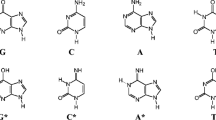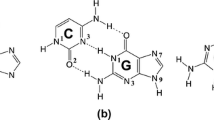Abstract
The total and relative energies, bond order matrices and localized MOs for the eight possible tautomers of hypoxanthine (HYP) have been calculated, with full geometry optimization, using both AM1 and MNDO methods. The AM1 relative energies show that HYP(9,1), HYP(7,1) and HYP (9,10) are the predominant species at room temperature, the two former being in larger concentration that the latter. The calculated IR spectra for these species agree well with the reported spectrum in an isolated matrix, which has been interpreted in terms of the presence of these three tautomeric forms. The MNDO method does not predict the right order, and the more stable tautomer would be HYP(9,10). The calculated structure for the HYP(9,1) species shows that the molecule is essentially planar. The bond distances compare well with those of hypoxanthine hydrochloride and guanine and also correlate well with the calculated bond orders. The proton affinities for the three more stable tautomers have also been calculated. For HYP(9,1) the prefered site of protonation is N7, whereas for HYP(7,1) the protonation occurs rather at N9. These results agree well with15N and13C NMR studies in DMSO.
Similar content being viewed by others
References
R. M. Izatt, J. J. Christensen and J. H. Ryttine:Chem. Rev. 71, 439 (1971).
G. W. Buchanan and M. J. Bell:Can J. Chem. 61, 2445 (1983).
R. L. Benoit and M. Frechette:Can. J. Chem. 63, 3053 (1985).
J. G. Contreras and J. B. Alderete:Bol. Soc. Chill. Quim. (in press).
J. G. Contreras and J. B. Alderete:J. Mol. Struct. (THEOCHEM) 231, 257 (1991).
W. Cochran:Acta Cryst. 4, 81 (1951).
Tables of Interatomic Distances, Special Publication No. 11, Chemical Society (1958).
P. G. Mezey and J. J. Ladik:Theoret. Chim. Acta 52, 129 (1979).
P. G. Mezey, J. J. Ladik and M. Barry:Theoret. Chim. Acta 54, 251 (1979).
J. G. Contreras, J. B. Alderete and J. A. Gnecco:J. Mol. Struct. (THEOCHEM) 251, 195 (1991).
G. C. Sheina, S. G. Stepanian, E. D. Radchenko and Y. P. Blagoi:J. Mol. Struct. 158, 275 (1987).
J. J. Aaron, M. D. Gaye, C. Parkanyi, N. S. Cho and L. V. Szentpaly:J. Mol. Struct. 156, 119 (1987).
A. B. Buda:J. Mol. Struct. (THEOCHEM) 149, 185 (1987).
R. Taylor and O. Kennard:J. Mol. Struct. 78, 1 (1982).
A. R. Katritzky:Physical Methods in Heterocyclic Chemistry 5, 312 (1972).
M. J. S. Dewar, G. P. Ford, M. L. McKee, H. S. Rzepa, W. Thiel and Y. Yamaguchi:J. Mol. Struct. 43, 135 (1978).
M. J. S. Dewar and K. M. Dieter:J. Am. Chem. Soc. 108, 8075 (1986).
J. F. Gal and P. C. Maria:Progress in Physical Organic Chemistry, R. W. Taft (editor)17, 159 (1990).
D. R. Stull and J. Prophet:Thermochemical Tables NSRDS-NBS37 (1971).
Author information
Authors and Affiliations
Rights and permissions
About this article
Cite this article
Contreras, J.G., Alderete, J.B. A semiempirical study of the prototropic tautomerism of hypoxanthine. Mol Eng 2, 29–36 (1992). https://doi.org/10.1007/BF00999520
Received:
Revised:
Issue Date:
DOI: https://doi.org/10.1007/BF00999520




